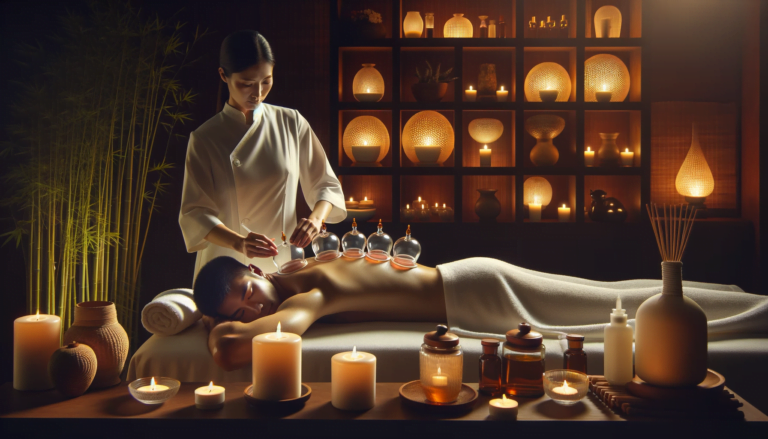Cupping therapy, an ancient practice steeped in the rich traditions of Chinese medicine, has experienced a resurgence in popularity due to its potential health benefits. This therapeutic technique, utilizing cups to create a vacuum seal on the skin, aims to alleviate pressure, tension, and promote healing.
With its ability to target various tissues and depths within the body, cupping therapy may offer relief for conditions such as back pain, respiratory problems, and mental health issues.
In this article, we delve into the history, benefits, and considerations of cupping therapy, providing valuable insights for those seeking natural and alternative treatments.
Key Takeaways
- Cupping therapy originated in China many centuries ago and was used to treat various conditions.
- Cupping therapy involves placing cups on the skin to create a vacuum-like seal, which breaks up adhesions and draws out toxins.
- Cupping therapy can affect tissues up to four inches deep, including blood vessels, muscles, fascia, and scar tissue.
- Cupping therapy has been found to be beneficial for conditions such as tight and stiff muscles, back pain, respiratory conditions, and mental health issues.
Origins and Early Use
Cupping therapy originated in China many centuries ago and was extensively used for various conditions. Early practitioners recognized the cultural significance of this therapy and its potential benefits. They believed that cupping could promote healing by improving blood flow, reducing inflammation, and releasing toxins from the body.
Bamboo, silicone, or glass cups were used to create a vacuum-like seal on the skin. The suction created by the cups would draw up superficial muscles, breaking up adhesions and stimulating the flow of energy. This therapy was believed to affect tissues up to four inches deep, making it a powerful treatment option.
Today, cupping therapy continues to be practiced worldwide, highlighting its enduring cultural and historical importance.
Cupping Process and Techniques
The process of cupping therapy involves the placement of cups on the skin to create a vacuum-like seal, drawing up superficial muscles and facilitating a range of therapeutic effects. There are different types of cupping techniques that can be used in this process, including:
- Dry Cupping: This technique involves placing cups on specific areas of the body without any additional substances. It is commonly used to relieve muscle tension and promote relaxation.
- Wet Cupping: In this technique, small incisions are made on the skin before applying the cups. This allows for the extraction of blood or other bodily fluids, believed to remove toxins and promote healing.
- Fire Cupping: Fire is used to create the vacuum seal in this technique. A flammable substance is ignited inside the cup, which is then quickly placed on the skin. The flame consumes the oxygen inside the cup, creating a suction effect.
- Massage Cupping: This technique combines cupping with massage. The cups are moved across the skin, creating a gentle pulling sensation that can help release tension and improve circulation.
Cupping therapy has also been used for sports injuries, as it can help alleviate muscle pain, reduce inflammation, and promote faster recovery. It is commonly used by athletes to enhance performance and prevent injuries.
Sensations and Effects on the Body
One of the key aspects of cupping therapy is the range of sensations and effects it produces on the body. During cupping therapy, individuals often report positive experiences, describing the sensation as a gentle suction that pulls away pressure and tension. It is often compared to a deep tissue massage, creating a pleasant experience for many.
Physiologically, cupping therapy can have several effects on the body. Circular marks varying in color from light yellow to dark purple may appear on the skin, caused by debris being pulled up and deposited under the skin. This therapy also creates space between tissue layers, allowing for the removal of dead cellular debris, toxins, and excess fluids.
These physiological effects contribute to the overall benefits of cupping therapy.
Conditions Treated With Cupping Therapy
Alleviating tight and stiff muscles, cupping therapy has shown effective results in treating a variety of conditions. Here are four conditions that can be treated with cupping therapy:
- Benefits of cupping for athletes: Cupping therapy can help athletes recover from strenuous workouts and injuries. It promotes blood circulation, reduces muscle soreness, and enhances muscle flexibility, leading to improved performance.
- Cupping therapy for digestive issues: Cupping therapy can aid in relieving digestive problems such as bloating, constipation, and irritable bowel syndrome. It stimulates the digestive system, improves nutrient absorption, and reduces inflammation in the gastrointestinal tract.
- Cupping therapy for respiratory conditions: Cupping therapy can assist in managing respiratory conditions like bronchitis and asthma. By improving lung function, reducing inflammation, and clearing mucus, it helps alleviate symptoms and enhance respiratory health.
- Cupping therapy for pain management: Cupping therapy is effective in treating various types of pain, including back pain, piriformis syndrome, and rotator cuff injuries. It helps relax muscles, reduce inflammation, and promote healing, providing relief from chronic or acute pain.
Considerations and Precautions
Considerations and precautions should be taken into account when undergoing cupping therapy. While cupping therapy offers numerous benefits, there are certain factors to consider to ensure a safe and effective experience. Two key considerations are avoiding cupping marks and the use of cupping therapy during pregnancy.
When it comes to cupping marks, it is important to note that circular marks may appear on the skin after a cupping session. These marks can vary in color, ranging from light yellow to dark purple, and may take a few days to a week to fade. For individuals who have special events like weddings or important social gatherings, it may be necessary to avoid areas that can leave distinct marks.
Additionally, pregnant women should exercise caution when considering cupping therapy. While cupping therapy is generally safe during pregnancy, it is not recommended for use on the lower abdomen or lower back. This precaution is taken to ensure the well-being of both the mother and the developing fetus.
To summarize the considerations and precautions for cupping therapy, individuals should be mindful of cupping marks and plan accordingly for any important events. Pregnant women should avoid cupping therapy on the lower abdomen and lower back. By taking these precautions, individuals can have a safe and effective cupping therapy experience.
| Considerations and Precautions | |
|---|---|
| Avoiding Cupping Marks | Cupping Therapy and Pregnancy |
| Circular marks may appear on the skin after a cupping session. | Pregnant women should avoid cupping therapy on the lower abdomen or lower back. |
| Marks can vary in color and may take a few days to a week to fade. | This precaution is taken to ensure the well-being of both the mother and the developing fetus. |
| Individuals with special events may need to avoid areas that leave distinct marks. | Cupping therapy is generally safe during pregnancy, but caution should be exercised. |
| Plan accordingly to minimize the visibility of cupping marks. | Ensure the safety and well-being of both the mother and the developing fetus. |
Frequently Asked Questions
How Long Does a Cupping Therapy Session Typically Last?
A typical cupping therapy session can last anywhere from 10 to 30 minutes, depending on the specific techniques used and the individual’s needs. The duration of the session is determined by the practitioner based on the desired therapeutic outcome.
Can Cupping Therapy Be Used to Treat Sports Injuries?
Cupping therapy can be used to treat sports injuries by promoting muscle recovery and relieving chronic pain. It helps increase blood flow, reduce inflammation, and release tension, making it beneficial for athletes seeking natural and holistic treatment options.
Are There Any Side Effects or Risks Associated With Cupping Therapy?
Cupping therapy carries minimal side effects and risks. Temporary circular marks may appear on the skin, but they fade within a few days. Pregnant women, individuals with damaged skin, or those taking blood thinners should avoid cupping therapy.
Is Cupping Therapy Painful?
Cupping therapy is generally not painful, but rather feels like a gentle suction. It is an effective treatment for various conditions, with scientific evidence supporting its benefits. When compared to other alternative therapies, cupping therapy has shown positive outcomes.
How Often Should One Undergo Cupping Therapy for Optimal Results?
The frequency of cupping therapy sessions for optimal results varies depending on individual needs and conditions. It is recommended to consult with a qualified practitioner who can assess and determine the ideal duration and frequency of sessions for each person.
Conclusion
In conclusion, cupping therapy has a long history and offers potential benefits for various conditions.
The use of cups to create a vacuum-like seal on the skin helps break up adhesions and remove toxins from the body.
This therapy can affect different tissues and provide relief from pressure and tension.
While circular marks may appear on the skin, they are a result of debris being pulled up and deposited under the skin.
Considerations and precautions should be taken into account when considering cupping therapy as a treatment option.






















